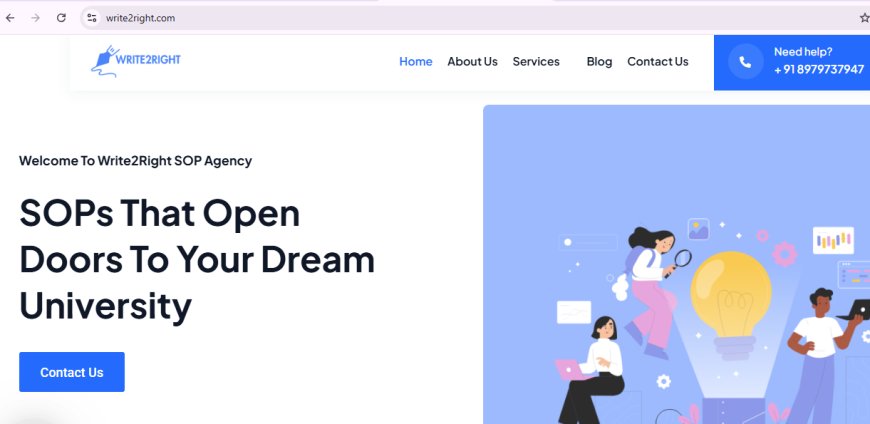Country-Wise SOP Guidelines (US, UK, Canada, Australia)
Learn how to write country-specific SOPs for the US, UK, Canada, and Australia. Follow expert tips, formats, and key differences to boost your study abroad success.

When applying to universities abroad, your Statement of Purpose (SOP) plays a central role in shaping how admissions committees perceive you. But here’s something many students overlook — SOP expectations vary from country to country.
Each study destination values different aspects of a student’s profile. What impresses a U.S. university might not be enough for a U.K. or Canadian institution. To stand out, you must tailor your SOP according to the country’s academic culture and admission style.
Here’s your country-wise guide to writing a winning SOP for top destinations like the U.S., U.K., Canada, and Australia.
🇺🇸 1. SOP for the United States
Purpose:
American universities treat the SOP as a personal and academic narrative. It’s your chance to share your story — who you are, what drives you, and why you’re passionate about your chosen field.
Tone and Style:
The U.S. values authenticity, creativity, and clarity of goals. Your SOP should sound personal yet professional, reflective yet focused.
Length:
Typically 800–1,000 words, unless the university specifies otherwise.
Structure and Key Points:
-
Introduction: A compelling hook or real-life experience that led you to your field of study.
-
Academic Background: Key academic milestones and how they’ve shaped your interests.
-
Professional Experience: Internships, jobs, or projects that demonstrate practical skills.
-
Motivation for the Course: Why this field? Why now?
-
Why This University: Specific faculty, research labs, or unique features that align with your goals.
-
Future Goals: Both short-term (post-graduation) and long-term aspirations.
Pro Tip:
U.S. universities value individuality. Avoid generic statements — tell your unique story and highlight what makes you stand out as a learner and leader.
🇬🇧 2. SOP for the United Kingdom
Purpose:
In the U.K., the SOP (often called the Personal Statement) is academic and concise. Admissions officers expect you to focus more on academic readiness than personal storytelling.
Tone and Style:
Formal and focused on your academic journey. Keep emotional or creative storytelling to a minimum.
Length:
Usually 500–700 words (UCAS allows up to 4,000 characters).
Structure and Key Points:
-
Introduction: A brief explanation of your interest in the subject.
-
Academic Achievements: Highlight relevant coursework, grades, and research work.
-
Skills and Strengths: Showcase skills that prove you can handle the course’s rigor.
-
Relevant Experience: Mention internships, workshops, or projects related to your subject.
-
Career Goals: Explain how the program aligns with your professional ambitions.
-
Conclusion: End with a strong statement about your enthusiasm and readiness.
Pro Tip:
U.K. universities value clarity, evidence, and academic focus. Avoid dramatic openings or long personal stories — stay results-driven and professional.
🇨🇦 3. SOP for Canada
Purpose:
Canadian universities expect a balanced SOP — one that’s personal yet professional, showing both academic excellence and personal motivation.
Tone and Style:
Your tone should be sincere, reflective, and well-organized. Canadian institutions appreciate clarity and structure, along with genuine enthusiasm for your chosen field.
Length:
Usually 1–2 pages (around 800–1,000 words).
Structure and Key Points:
-
Introduction: Start with a clear motivation or defining experience.
-
Academic History: Outline your education and how it led to your area of interest.
-
Professional Experience: Include relevant internships, jobs, or volunteer work.
-
Why This Program and University: Mention course specifics and how they align with your goals.
-
Why Canada: Briefly explain why you chose Canada as a study destination.
-
Career Plans: Show both short-term and long-term goals, ideally connected to global impact or community contribution.
Pro Tip:
Canadians value honesty and clarity. Don’t exaggerate achievements; focus on how you’ll grow academically and personally through their education system.
🇦🇺 4. SOP for Australia
Purpose:
An Australian SOP (often required for both university admission and student visa purposes) must highlight academic goals, financial preparedness, and genuine intent to study.
Tone and Style:
Professional and factual, yet engaging. Avoid being overly emotional — clarity and honesty are key.
Length:
Approximately 1,000–1,500 words, depending on the university’s or visa requirements.
Structure and Key Points:
-
Introduction: Your academic interest and reasons for choosing the course.
-
Educational Background: Academic performance and relevant experiences.
-
Work Experience: Mention internships or employment relevant to the course.
-
Why This University and Course: Include specific features or programs that match your goals.
-
Why Australia: Show understanding of Australia’s education system and opportunities.
-
Career Goals: State how the course fits your long-term professional plans.
-
Visa Relevance: Include a brief statement proving your Genuine Temporary Entrant (GTE) intent — that you plan to return home after studies.
Pro Tip:
Australian universities and visa officers look for clarity of purpose and authenticity. Don’t copy templates — write your SOP in your own words, showing genuine academic intent.
5. Key Differences at a Glance
| Aspect | USA | UK | Canada | Australia |
|---|---|---|---|---|
| Tone | Personal & Story-driven | Academic & Formal | Balanced & Reflective | Professional & Direct |
| Length | 800–1000 words | 500–700 words | 800–1000 words | 1000–1500 words |
| Focus | Goals, research interests, individuality | Academic readiness & skills | Academic + personal motivation | Course fit, GTE intent, financial readiness |
| Style | Narrative & engaging | Concise & factual | Structured & sincere | Formal & detailed |
| Key Section | Why this program/university | Academic evidence | Why Canada + goals | Why Australia + GTE |
6. Final Tips for All SOPs
No matter where you apply, follow these golden rules for writing a strong SOP:
✅ Be honest and authentic — avoid exaggerations.
✅ Use simple, professional language.
✅ Follow each university’s format and word limits.
✅ Proofread thoroughly for grammar and clarity.
✅ Tailor each SOP — never reuse one version for multiple countries.
Final Thoughts
Your SOP is your personal statement of intent — it reflects your values, vision, and readiness for global education. While the structure and expectations differ across countries, the core purpose remains the same: to show who you are and why you belong in that program.
Craft it carefully, personalize it deeply, and let your story speak for itself. A thoughtful SOP can be your passport to not just a new university, but a life-changing global experience.


























